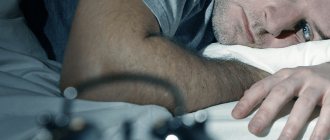Article:
Such a phenomenon as sleepwalking is not so rare in children. Sleep disturbance leads to the child getting out of bed, walking, and performing some actions. He does this unconsciously, and the next morning he doesn’t remember anything. Parents do not always understand the reason for this behavior, sometimes even consider it a mystical phenomenon. But there are very real reasons why it manifests itself in children. First of all, sleepwalking is explained by the peculiarities of the development of the children's nervous system. Most often, in adulthood, sleep improves. But sometimes we are talking about neurological pathology.
What is sleepwalking
Sleepwalking is also called somnambulism (or “sleepwalking”). Most often, this sleep disorder is observed in children over 4 years of age. Some of them experience periodic episodes of sleepwalking even in adolescence. This deviation can be combined with other types of parasomnia (sleep disorder). For example, a sleeping person talks and laughs under the impression of previously experienced emotions. Somnambulism has a similar nature to such manifestations as involuntary urination at night (enuresis) or nightmares.
Sleep disorder is due to the fact that the child’s brain cannot always adequately perceive the variety of information that enters it. His work continues even at night, when he is supposed to rest. The immature nervous system reacts violently to events that occur during the day, which continue to excite the brain during sleep. Impressed by a scary cartoon or movie, playing on the computer, an unpleasant or joyful meeting, or a quarrel with relatives, the child cannot fall asleep for a long time, and continues to worry in his sleep.
During normal sleep, the work of all parts of the brain, including those responsible for movement, is inhibited. Therefore, muscles relax, energy consumption decreases, and the body rests.
During episodes of sleepwalking in a child, part of the brain centers responsible for perception and awareness of reality is switched off, but the part that regulates physical activity continues to work. The brain sends false signals, and the body reacts to arousal caused by imaginary events.
What is childhood sleepwalking (somnambulism), its causes and signs
Sleep, including children's sleep, is an alternation of two phases - the phase of rapid (shallow) sleep and the phase of slow (deep) sleep. It is the deep sleep phase, its last 4 stages, that is characterized by dreams. During phase 4 of deep sleep or the beginning of awakening, the central nervous system continues to fully control the areas of the brain that are responsible for the child’s motor activity, this ensures his immobility during sleep. With sleepwalking (somnambulism or sleepwalking), the control process is disrupted - spontaneous activity of these areas of the brain appears, the child begins to make movements that are not typical for the sleep period, for example, he can sit on the bed, stand up, start moving, or actions familiar to his everyday life. At the same time, the child continues to sleep, and the rest of his brain is inactive at this moment, as it should be during sleep.
The normal functioning of the human brain is characterized by two main processes - excitation and inhibition, which, replacing each other, ensure our “functioning”. Starting from the moment we fall asleep and throughout sleep, in all parts of the brain, the processes of inhibition overlap the processes of excitation. However, situations arise when not all parts of our brain obey this process. Individual nerve cells of the zones that provide movement are triggered, turning these zones into work, while the areas of the cerebral cortex responsible for conscious activity continue to be “turned off.” Such a failure ultimately leads to the appearance of signs of sleepwalking.
Signs of sleepwalking in children
The first signs of unusual behavior in children are most often recorded in the period from 4 to 8 years (in some sources - up to 10-11 years). What should you pay attention to?
- the child often, seemingly for no apparent reason, talks in his sleep;
- the child may suddenly sit up in bed, with a complete feeling that he has woken up, although there is no reaction to external stimuli;
- if a child sleeps in his room, in the morning you may find toys in his bed, although he himself does not remember how they got there;
- you may find the child sleeping on the floor, near the bed, or even in another room;
- if you find a child standing (or sitting) in another room with clear, open eyes, but he does not respond to your voice and does not answer your questions (sleeps with his eyes open).
Photo source: shutterstock.com
Causes of symptoms of sleepwalking
Speaking about the causes and treatment of sleepwalking in children, one cannot fail to mention the importance of timely contact with neurologists and attentive attitude to the child and his condition. The fact is that sleepwalking can be dangerous for a child’s health, because he cannot take any precautions during “night walks.” In addition, the lack of proper sleep and rest also cannot but affect the child’s well-being and emotional background. Among the main causes of childhood sleepwalking, several of the most common can be named.
Age characteristics of the child
Normally, the child’s nervous system will be fully formed only when he reaches preschool age. Before this moment occurs, situations may occur when nerve cells with an abnormal “working program” appear in the cerebral cortex, which lead to disruption of the processes of excitation and inhibition, which provokes the development of sleepwalking in a child.
Stress, increased anxiety, fear
The imperfection of the children's nervous system leads to an increased intensity of reaction to external emotional stimuli such as stress or fear.
- Prolonged exposure of a child to a state of stress can lead to physiological disorders, namely hormonal imbalance and a decrease in the immune (protective) functions of the body. And this, in turn, serves as an impetus for sleep disturbances and the development of sleepwalking;
- The feeling of fear that a child experiences immediately before bed or during the period of falling asleep negatively affects the quality of the child's sleep. Fright or fear caused by external stimuli activates the child’s central nervous system, increasing the time it takes to fall asleep and the time of the shallow sleep phase, which leads to disturbances in the correct alternation of phases. The child does not get enough sleep, gets up feeling tired and weak. In addition, he may be haunted by unpleasant dreams, which are often not remembered, but leave the child with a painful feeling and a feeling of anxiety.
Overexertion and fatigue
The appearance of spontaneous activity in the areas of the brain responsible for movement can be facilitated by the child’s fatigue. A day that is too full of emotions or fatigue from daytime school activities (often sports classes) can trigger unusual brain activity and the awakening of signs of somnambulism.
Traumatic brain injuries and epilepsy
Quite often, diseases in which organic damage to the brain and its membranes are observed, in addition to the main ones, also have symptoms of sleepwalking.
Neuroses and other mental disorders
The cause of the development of sleepwalking may be deviations in the functioning of the central nervous system, leading to the appearance, for example, of neuroses. It is often difficult for us to adequately assess the condition of our child, to understand what of his behavior is normal and what should alarm us. The fact is that the development of such disorders goes almost unnoticed; the deterioration of the child’s condition takes quite a long time. Unfortunately, parents, in most cases, turn to specialists only when the disorder has gone very far and, instead of light corrective therapy, long-term treatment, including medication, is required.
Photo source: shutterstock.com
Causes of sleepwalking
As you know, people have 2 phases of sleep: slow and fast. During the night they alternate with each other, and this happens 4-5 times.
REM sleep can be superficial. When a person wakes up, he does not remember his dreams. If this phase prevails in duration, then he feels poorly rested and sleep-deprived.
NREM sleep normally lasts longer and occurs in 4 stages, each of which has its own characteristics (drowsiness, gradual shutdown of the brain, transition period and deep sleep). The last stage is the most difficult to awaken a person.
It is at the fourth stage of slow-wave sleep that children may experience manifestations of sleepwalking. Factors that provoke sleepwalking may include:
- strong feelings (both negative and positive);
- fear, fear of the dark, making sleep restless;
- mental stress due to workload at school, additional classes with tutors;
- lack of entertainment and active recreation, which children especially need.
The causes of somnambulism may be more serious. Sleepwalking manifests itself against the background of epilepsy, neuroses, mental illness, and brain damage. Brain function can be impaired as a result of head injury, tumor formation, as a consequence of meningitis, encephalitis and some other diseases. The cause of impaired brain activity in a baby is also infection with worms (they deprive the body of nutrients and, in addition, can penetrate directly into the brain).
Somnambulism is often a phenomenon that is inherited. The performance of involuntary actions during sleep is facilitated by a noisy environment surrounding a sleeping baby, sudden switching on of lights, or sleeping in a lit room.
The phenomenon was called “sleepwalking”, as it was noticed that the light of the moon can affect the sleeping person. Sleepwalking is more common during the full moon.
A similar phenomenon occurs more often in boys. In girls, episodes of sleepwalking are sometimes observed in connection with the appearance of menstruation and the corresponding hormonal changes in the body. The occurrence of sleep disturbances is facilitated by the presence of certain pathologies in the child, such as cardiac arrhythmia, asthma, night cramps, apnea (periodic stops of breathing).
Reasons for appearance
Why does a child sleepwalk? Knowing the causes of such a condition is the first step to defeating it. Most often, the following factors provoke the appearance of this phenomenon:
- stressful situations;
- change of team;
- constant state of anxiety;
- excessive emotionality;
- nightmares seen.
As a rule, with such factors, the phenomenon gradually disappears without a trace as soon as the child’s psyche becomes stronger.
It is worth noting that in some cases a child may sleepwalk due to epilepsy. With this pathology, the signs will be as follows:
- sleepwalking will be observed for no more than 4 minutes;
- there will be pronounced trembling of the legs and arms;
- sleep will become restless or insomnia will appear.
And the third most common provocateur, as a result of which a child walks in his sleep, is severe fatigue caused by increased physical and intellectual stress. For example, a rich school program, supplemented by various clubs and activities.
In addition, a child may walk in his sleep due to the following factors:
- due to injury;
- due to infectious pathology;
- with enuresis;
- for various personality disorders;
- pathologies of the central nervous system;
- due to heredity.
In any case, if such signs appear, parents need to visit a doctor and have the little sleepwalker examined.
What is the danger of somnambulism?
Involuntary and uncontrollable actions performed by a sleepwalker lead to dangerous situations. When getting out of bed, he may trip or hit himself, pick up dangerous objects (scissors, a knife), or touch an electrical wire.
Warning: It is dangerous to leave a window or balcony open (the sleeper may fall out). A sleepwalker is able to open the door and go outside, into an unfamiliar place. A teenager is able to get into a car and drive away mechanically. Accordingly, a danger is created not only for himself, but also for the people around him.
What to do and how to treat
How to cure sleepwalking in a child? It is possible to cure a child who walks in his sleep only by determining the cause of somnambulism.
In the vast majority of cases, the disease does not require any treatment at all, and after puberty ends, it goes away on its own.
The main thing that parents should do when they discover a child walking in his sleep is to carefully observe his movements, without making sudden movements or trying to wake him up. Any loud or sharp sound can frighten a sleepwalker, even to the point of loss of consciousness.
It is necessary to hide all dangerous objects away, install bars on the windows, and close the doors tightly. Such measures will maximize the safety of the child from accidental injuries.
To reduce attacks of sleepwalking to a minimum, it is necessary to provide comfortable conditions, a calm and favorable environment in the family, and remove the computer and TV from the bedroom. The child should get proper rest, including during the day.
Medications
Medicines are prescribed to treat concomitant diseases that accompany sleepwalking.
If sleepwalking is provoked by epilepsy, then it is necessary to take special anticonvulsants (Carbamazepine, Valparin, Phenobarbital, etc.).
All of these products are strictly prescription, approved for use by children over 3 years of age.
Only a highly qualified specialist should calculate the dosage and duration of the course, after confirming the diagnosis.
When somnambulism is accompanied by chronic fatigue syndrome, anxiety, and some mental disorders, you will need to take antidepressants (Glycine, Prozac, Sertraline).
You must understand that these are very heavy drugs that are used only in cases where other, less safe means cannot be used.
In some cases, the doctor will recommend benzodiazepines - psychotropic drugs that reduce anxiety and panic in a child.
It happens that walking or talking in a dream is caused by a sharp increase in temperature due to a viral or infectious disease, or high intracranial pressure. In this case, taking antipyretics and diuretics will help to alleviate the child’s condition.
Folk remedies
If sleepwalking is not associated with pathological changes in the psyche and nervous disorders, then the use of traditional methods of treatment is quite suitable.
Experienced healers advise placing a wet towel or rug near the patient’s bed.
Trying to get up in a dream, the sleepwalker steps on a cold, damp cloth and either wakes up or goes back to bed.
Special herbal baths are used as sedatives to speed up sleep. Immediately before bedtime, the child should take a pine bath with salt.
It’s very simple to prepare, just take fresh spruce branches and pine needles, boil for a couple of minutes and let it brew for about half an hour.
Strain the broth, pour into the bath, add well-warm water and 200 g of coarse table salt. It is enough to lie in pine water for at least 30 minutes and immediately go to bed.
Drinking a glass of warm milk or honey water at night helps normalize sleep.
You can hang rag bags filled with dry herbs of lemon balm, lavender, mint, St. John's wort over the bed, or leave an open bottle of ylang-ylang essential oil nearby.
Excellent results are achieved by using soothing herbal infusions, but only after consultation with a specialist. One of them is an infusion of dry leaves of lemon balm, lavender and valerian root.
Unconventional methods
Often, therapy methods such as hypnosis, acupuncture, and physiotherapy are used to eliminate pathology.
Relaxing massage and electrosleep help a lot.
Many parents are wary of such treatment, and that is their right.
The doctor himself decides what the patient needs in a particular case.
Manifestations and symptoms of sleepwalking
Uncontrolled sleep behavior leads to movements of varying complexity. In the best case, the sleeper assumes a sitting position, but he can also get out of bed, sort through toys, change clothes on his own, and go to the kitchen.
The feature is as follows:
- The sleepwalker's consciousness is switched off. Despite this, he is able to move actively and confidently. He automatically answers simple questions, but does not adequately perceive speech addressed to him.
- There is no sense of danger.
- The sleeper moves with his eyes open, but is not aware of what he sees. The facial expression does not change, emotions are not reflected on it.
- Memories of what happened during this time completely disappear.
- The episodes end with the child going back to bed or falling asleep where he finds the end of the episode of somnambulism, and then plunging into normal sleep. An episode of uncontrolled activity can last from 10 minutes to 1 hour. Usually begins 2-3 hours after the child falls asleep.
It is very difficult to wake up a sleepwalker while performing such involuntary actions. In this case, waking up after a loud shout, strong shaking, splashing with cold water can lead to the fact that the awakened person is very frightened, not understanding what is happening, and reacts aggressively.
Main symptoms
Sleepwalking is characterized not only by unconscious walking in a dream. The signs of the disorder are varied, but if you monitor your child’s sleep behavior, they can be easily identified. A teenager suffering from sleepwalking does not always walk around the house with his arms outstretched in front of him. This is more of a common misconception than a rule. Symptoms of sleep disorders manifest themselves in different ways. The most common ones are:
- indistinct muttering in sleep;
- the teenager sits on the bed and remains in this position for a long time, after which he lies down again;
- moving and twitching of arms and legs;
- walking around the house in your sleep;
- sleep with eyes open;
- smacking your lips in your sleep;
- rubbing hands.
However, in adolescents, signs of the disorder may appear in a more pronounced form. For example, a child can regularly walk around the house, move things, and even go outside. Retarded movements and complete disorientation are observed. The eyes are most often closed. But if they are open, then the look is detached.
Sleeping with your eyes open is one of the symptoms of sleepwalking.
Depending on the symptoms of sleepwalking, treatment may include sedatives or more serious therapy. During an attack there is no external reaction. Many teenagers wake up in the morning not in their bed, and cannot remember how this happened.
Some teenagers may scream or even act aggressively towards others during an attack. Therefore, it is extremely important not to try to wake up a sleepwalker. You need to carefully take him to your room and put him to bed.
What to do if your child experiences somnambulism
Pediatricians do not consider sleepwalking a serious illness. According to the authoritative opinion of the famous doctor, author of popular programs about children's health, E. Komarovsky, there is no need to worry if such behavior in a child occurs sporadically in a dream, while it is clearly preceded by some specific provoking events. You just need to think about safety measures for the children themselves and those around them.
However, in some cases it is necessary to consult a doctor, especially if the episodes occur frequently, the child looks tired after them, or there are signs of physical and nervous exhaustion.
You should contact a pediatric neurologist or psychiatrist.
Sleepwalking in a child: a few facts
According to sleep researchers, sleepwalking is associated with deep phase sleep . Sleep in this phase is as deep as possible, and the sleeper simply does not control his body. The reins of power in this case are given to the subconscious, when all actions and movements are performed automatically by a person. Well, the conscious part of the brain is very inactive in the slow phase of sleep.
Children and adolescents in a state of sleepwalking do not control their movements. At the same time, on autopilot they can perform actions quite complex for an unconscious state. For example, get dressed and go out for a walk. Such manifestations of somnambulism are already dangerous to life and health .
Sleep talking in children is also associated with sleepwalking. The child can answer questions quite clearly, maintaining a dialogue with his parents. Nevertheless, everything heard and said will not be deposited in his memory.
The open eyes of a child during night walks do not mean that the child sees and understands everything.
Most often, a child begins to walk in his sleep at the age of 4. At this age, you need to monitor how your child spends his nights. If there is suspicious behavior at night, you should take your child to the doctor.
High-quality orthopedic mattresses with discounts on the official Ascona website
Sleepwalking in adolescents stops by the age of 12-15 - at the height of puberty. Some people experience somnambulism even at 17-18 years of age. However, this is rarely observed.
An episode of sleepwalking lasts 15-60 minutes. On average, its duration is no more than 30 minutes.
As the depth of sleep increases, the likelihood of sleepwalking increases. Therefore, most cases of sleepwalking occur at 1-2 am, after the 2nd or 3rd phase of slow-wave sleep.
How are sleep disorders diagnosed?
In order to establish how dangerous the existing phenomenon is in this case, the doctor must know how long the episodes last, how often they are repeated, and what actions the patient performs. The presence of additional manifestations (fainting, headaches, dizziness, other sleep disorders), as well as diseases and provoking factors, is taken into account.
A brain examination using MRI or electroencephalography (a procedure during which electrical impulses emitted by various parts of the brain are recorded) may be prescribed.
An effective method for identifying the causes of sleepwalking is polysomnography. Using sensors installed on different parts of the body and computer data processing, the activity of a sleeping person’s body is studied and deviations from the norm are identified.
Treatment for somnambulism
It is carried out when obvious health problems or pathologies associated with the state of the brain and nervous system are detected.
In the absence of obvious diseases, only recommendations are given on creating conditions for healthy sleep and eliminating factors that provoke the occurrence of disorders. In difficult cases, it is suggested to use hypnosis.
Indications for mandatory drug treatment are:
- the young patient has epilepsy (antiepileptic drugs Felbatol, Depakote are prescribed);
- the appearance of neuroses and depression (sedatives valerian, Novo-Passit, psychotropic drugs are used);
- detection of worms (antiparasitic drugs Pirantel, Dekaris are used).
If it is discovered that sleepwalking in children is a consequence of a brain tumor or head injury, surgical treatment is performed.
How to treat sleepwalking in Saratov?
The Sarclinic doctor knows how to treat sleepwalking in Saratov . If the patient says: “I suffer from sleepwalking, what should I do?” We answer: “Go to a specialist for treatment!” At the first consultation, the doctor will tell you what childhood sleepwalking and adult sleepwalking , what teenage sleepwalking is (in teenagers), how to treat the disease sleepwalking, why conspiracies for sleepwalking do not help, whether the army and sleepwalking are combined, why sleepwalking is dangerous. You can ask the doctor a question for free online. Can sleepwalking acquired in adulthood be cured ? Yes, with complex treatment at Sarklinik.
Sign up for a consultation. There are contraindications. Specialist consultation is required.
Photo 1: Gnanamdesigns | Dreamstime.com\Dreamstock.ru. The people depicted in the photo are models, do not suffer from the diseases described and/or all similarities are excluded. Photo 2, 3: (©) Pechennikova VV | Sarclinic.com \ Sarclinic.ru
Related posts:
Autism in children, childhood autism, correction, treatment in Saratov
Alalia for children, alalia treatment, motor, sensory, sensorimotor
Tourette, Tourette syndrome, Tourette's disease, treatment Gilles de la Tourette
Minimal brain dysfunction in children, treatment of mmd in children
Sound, vocal tics in children: treatment, symptoms; adult tics










